| SymptomName | Count of Bacteria Species Used | Log Odds Ratio | Odds Ratio |
| Official Diagnosis: Chronic Fatigue Syndrome (CFS/ME) | 328 | 115.96 | 2.30E+50 |
| General: Fatigue | 265 | 114.92 | 8.08E+49 |
| Sleep: Unrefreshed sleep | 260 | 107.44 | 4.58E+46 |
| Post-exertional malaise: Inappropriate loss of physical and mental stamina, | 182 | 82.70 | 8.21E+35 |
| DePaul University Fatigue Questionnaire : Post-exertional malaise, feeling worse after doing activities that require either physical or mental exertion | 174 | 82.33 | 5.70E+35 |
| Post-exertional malaise: General | 169 | 80.38 | 8.06E+34 |
| Post-exertional malaise: Rapid cognitive fatigability, | 142 | 78.53 | 1.27E+34 |
| Neurocognitive: Difficulty paying attention for a long period of time | 229 | 77.62 | 5.13E+33 |
| Immune Manifestations: Bloating | 236 | 77.03 | 2.84E+33 |
| Immune Manifestations: Constipation | 188 | 74.68 | 2.71E+32 |
| Condition: ME/CFS without IBS | 109 | 74.57 | 2.43E+32 |
| Neurocognitive: Brain Fog | 241 | 74.12 | 1.55E+32 |
| Post-exertional malaise: Muscle fatigue after mild physical activity | 197 | 74.01 | 1.38E+32 |
| Comorbid: Mold Sensitivity / Exposure | 132 | 73.91 | 1.25E+32 |
| Sleep: Daytime drowsiness | 226 | 73.49 | 8.23E+31 |
| Neurological-Sleep: Insomnia | 193 | 73.26 | 6.56E+31 |
| Gender: Female | 202 | 72.33 | 2.57E+31 |
| Comorbid: Histamine or Mast Cell issues | 226 | 69.91 | 2.29E+30 |
| DePaul University Fatigue Questionnaire : Walking up early in the morning (e.g. 3AM) | 114 | 67.49 | 2.05E+29 |
| Sleep: Problems staying asleep | 159 | 66.42 | 7.00E+28 |
| Official Diagnosis: Autism | 98 | 63.66 | 4.44E+27 |
| Post-exertional malaise: Post-exertional malaise | 174 | 62.70 | 1.69E+27 |
| Immune Manifestations: Inflammation (General) | 174 | 62.30 | 1.14E+27 |
| Age: 30-40 | 127 | 61.90 | 7.66E+26 |
| Post-exertional malaise: Worsening of symptoms after mild physical activity | 196 | 61.84 | 7.18E+26 |
| Neuroendocrine Manifestations: intolerance of extremes of heat and cold | 145 | 60.31 | 1.55E+26 |
| DePaul University Fatigue Questionnaire : Ringing in the Ears | 125 | 59.58 | 7.54E+25 |
| Blood Type: O Positive | 176 | 59.05 | 4.42E+25 |
| DePaul University Fatigue Questionnaire : Unrefreshing Sleep, that is waking up feeling tired | 162 | 57.88 | 1.37E+25 |
| DePaul University Fatigue Questionnaire : Difficulty staying asleep | 118 | 57.21 | 7.04E+24 |
| Neurocognitive: Absent-mindedness or forgetfulness | 138 | 55.92 | 1.92E+24 |
| Official Diagnosis: COVID19 (Long Hauler) | 120 | 55.81 | 1.73E+24 |
| Post-exertional malaise: Next-day soreness after everyday activities | 121 | 55.78 | 1.68E+24 |
| Physical: Amalgam fillings | 82 | 55.72 | 1.59E+24 |
| DePaul University Fatigue Questionnaire : Chemical sensitivity | 116 | 55.70 | 1.56E+24 |
| Comorbid: Restless Leg | 77 | 55.69 | 1.53E+24 |
| DePaul University Fatigue Questionnaire : Muscle weakness | 98 | 55.28 | 1.01E+24 |
| Gender: Male | 192 | 53.43 | 1.59E+23 |
| Neurological-Audio: Tinnitus (ringing in ear) | 169 | 53.16 | 1.22E+23 |
| Neurological-Audio: hypersensitivity to noise | 147 | 52.81 | 8.65E+22 |
| Age: 50-60 | 100 | 52.15 | 4.44E+22 |
| DePaul University Fatigue Questionnaire : Difficulty falling asleep | 89 | 51.26 | 1.83E+22 |
| Neuroendocrine Manifestations: Poor gut motility | 91 | 50.82 | 1.17E+22 |
| Neurocognitive: Can only focus on one thing at a time | 158 | 50.38 | 7.61E+21 |
| Neuroendocrine Manifestations: subnormal body temperature | 132 | 50.01 | 5.24E+21 |
| Immune: Sensitivity to smell/food/medication/chemicals | 94 | 49.92 | 4.77E+21 |
| Neurological: Executive Decision Making (Difficulty making) | 92 | 49.41 | 2.87E+21 |
| Neuroendocrine Manifestations: worsening of symptoms with stress. | 157 | 49.34 | 2.68E+21 |
| Sleep: Waking up early in the morning (e.g. 3 AM) | 188 | 49.31 | 2.60E+21 |
| Neurological: Cognitive/Sensory Overload | 102 | 49.11 | 2.12E+21 |
| Condition: ME/CFS with IBS | 88 | 48.68 | 1.38E+21 |
| Neuroendocrine: Lost or gained weight without trying | 104 | 48.07 | 7.55E+20 |
| Post-exertional malaise: Mentally tired after the slightest effort | 86 | 47.79 | 5.70E+20 |
| Autism: High Functioning | 46 | 47.65 | 4.93E+20 |
| Autonomic Manifestations: irritable bowel syndrome | 124 | 47.61 | 4.75E+20 |
| Neurological: Impairment of concentration | 122 | 47.55 | 4.48E+20 |
| Post-exertional malaise: Physically tired after minimum exercise | 166 | 46.94 | 2.44E+20 |
| Comorbid: High Anxiety | 140 | 46.34 | 1.33E+20 |
| DePaul University Fatigue Questionnaire : Does physical activity make you feel worse | 112 | 45.91 | 8.68E+19 |
| DePaul University Fatigue Questionnaire : Impaired Memory & concentration | 133 | 45.57 | 6.21E+19 |
| Other: Sensitivity to mold | 75 | 44.82 | 2.91E+19 |
| Neurological: emotional overload | 100 | 44.55 | 2.24E+19 |
| Physical: Long term (chronic) stress | 81 | 44.43 | 1.97E+19 |
| Neuroendocrine Manifestations: cold extremities | 106 | 44.11 | 1.43E+19 |
| Post-exertional malaise: Physically drained or sick after mild activity | 154 | 43.73 | 9.81E+18 |
| DePaul University Fatigue Questionnaire : Difficulty retaining information | 86 | 43.71 | 9.64E+18 |
| DePaul University Fatigue Questionnaire : Anxiety/tension | 119 | 43.58 | 8.42E+18 |
| DePaul University Fatigue Questionnaire : Abnormal sensitivity to light | 94 | 43.04 | 4.91E+18 |
| Post-exertional malaise: Worsening of symptoms after mild mental activity | 76 | 42.97 | 4.57E+18 |
| DePaul University Fatigue Questionnaire : Frequently loose train of thought | 97 | 42.70 | 3.52E+18 |
| Neuroendocrine Manifestations: Muscle weakness | 92 | 42.24 | 2.20E+18 |
| DePaul University Fatigue Questionnaire : Forgetting what you are trying to say | 74 | 42.20 | 2.12E+18 |
| Autonomic Manifestations: Orthostatic intolerance | 75 | 41.99 | 1.72E+18 |
| DePaul University Fatigue Questionnaire : Need to have to focus on one thing at a time | 102 | 41.79 | 1.41E+18 |
| DePaul University Fatigue Questionnaire : Fatigue | 148 | 41.31 | 8.76E+17 |
| DePaul University Fatigue Questionnaire : Easily irritated | 99 | 41.21 | 7.93E+17 |
| General: Heavy feeling in arms and legs | 72 | 40.89 | 5.76E+17 |
| DePaul University Fatigue Questionnaire : Tingling feeling | 53 | 40.45 | 3.69E+17 |
| Autonomic: Heart rate increase after standing | 94 | 40.22 | 2.94E+17 |
| Comorbid: Multiple Chemical Sensitivity | 118 | 40.14 | 2.70E+17 |
| Age: 60-70 | 136 | 40.10 | 2.59E+17 |
| Neurocognitive: Unable to focus vision and/or attention | 157 | 39.74 | 1.82E+17 |
| Immune Manifestations: general malaise | 118 | 39.53 | 1.48E+17 |
| Sleep: Problems falling asleep | 89 | 39.33 | 1.21E+17 |
| DePaul University Fatigue Questionnaire : Upset stomach | 53 | 39.22 | 1.08E+17 |
| DePaul University Fatigue Questionnaire : Weight change | 49 | 38.97 | 8.38E+16 |
| Comorbid-Mouth: Bruxism – Jaw cleanching / Teeth grinding | 198 | 38.52 | 5.36E+16 |
| Neurological: Difficulty reading | 108 | 38.14 | 3.67E+16 |
| General: Depression | 142 | 37.20 | 1.43E+16 |
| Post-exertional malaise: Difficulty reading after mild physical or mental activity | 93 | 36.73 | 8.96E+15 |
| Neurocognitive: Problems remembering things | 137 | 36.64 | 8.17E+15 |
| DePaul University Fatigue Questionnaire : Slowness of thought | 51 | 36.57 | 7.62E+15 |
| Neurological: Short-term memory issues | 76 | 36.47 | 6.93E+15 |
| Post-exertional malaise: Rapid muscular fatigability, | 85 | 35.94 | 4.04E+15 |
| Autonomic: Shortness of breath | 60 | 35.79 | 3.49E+15 |
| Condition: Acne | 42 | 35.67 | 3.11E+15 |
| DePaul University Fatigue Questionnaire : Difficulty finding the right word | 109 | 35.22 | 1.98E+15 |
| Neurological: Word-finding problems | 128 | 34.89 | 1.42E+15 |
| Official Diagnosis: Autoimmune Disease | 111 | 34.69 | 1.16E+15 |
| Age: 40-50 | 83 | 34.38 | 8.54E+14 |
| Infection: Coxsackie | 21 | 34.04 | 6.09E+14 |
| Autonomic: Inability to tolerate an upright position | 86 | 33.92 | 5.39E+14 |
| Official Diagnosis: Allergic Rhinitis (Hay Fever) | 78 | 33.43 | 3.29E+14 |
| Neurological: Joint hypermobility | 129 | 33.40 | 3.19E+14 |
| Neurological-Vision: Blurred Vision | 74 | 33.01 | 2.16E+14 |
| Neurological-Sleep: Inability for deep (delta) sleep | 66 | 32.90 | 1.94E+14 |
| Neuroendocrine: Feeling hot or cold for no reason | 64 | 32.53 | 1.34E+14 |
| Neuroendocrine: Cold limbs (e.g. arms, legs hands) | 67 | 32.47 | 1.26E+14 |
| Neuroendocrine: Feeling like you have a high temperature | 40 | 32.34 | 1.11E+14 |
| Neurocognitive: Difficulty expressing thoughts | 103 | 31.91 | 7.25E+13 |
| Comorbid: Panic Attacks | 60 | 31.38 | 4.24E+13 |
| Autonomic Manifestations: Postural orthostatic tachycardia syndrome (POTS) | 60 | 31.31 | 3.95E+13 |
| Immune Manifestations: Alcohol Intolerant | 116 | 31.17 | 3.44E+13 |
| DePaul University Fatigue Questionnaire : Difficulty comprehending Information | 67 | 30.91 | 2.65E+13 |
| General: Sinus issues with headaches | 83 | 30.86 | 2.52E+13 |
| Neurological: Dysautonomia | 67 | 30.33 | 1.49E+13 |
| DePaul University Fatigue Questionnaire : Tense muscles | 49 | 30.33 | 1.49E+13 |
| Neurocognitive: Slowness of thought | 92 | 30.17 | 1.27E+13 |
| DePaul University Fatigue Questionnaire : Trouble expressing thoughts | 55 | 30.15 | 1.24E+13 |
| Comorbid: Constipation and Explosions (not diarrohea) | 66 | 30.10 | 1.18E+13 |
| DePaul University Fatigue Questionnaire : Absent-mindedness | 65 | 29.82 | 8.92E+12 |
| Neuroendocrine Manifestations: Dry Eye (Sicca or Sjogren Syndrome) | 61 | 29.79 | 8.63E+12 |
| Official Diagnosis: Celiac Disease | 13 | 29.61 | 7.26E+12 |
| Immune Manifestations: Abdominal Pain | 111 | 29.48 | 6.33E+12 |
| Neurological: Difficulty processing information (Understanding) | 78 | 29.41 | 5.92E+12 |
| Autonomic Manifestations: Cortisol disorders or irregularity | 47 | 29.36 | 5.65E+12 |
| Immune Manifestations: Mucus in the stool | 97 | 29.35 | 5.57E+12 |
| Pain: Joint pain | 65 | 29.33 | 5.48E+12 |
| DePaul University Fatigue Questionnaire : Need to nap during each day | 64 | 29.32 | 5.40E+12 |
| Comorbid: Migraine | 44 | 28.54 | 2.47E+12 |
| Immune Manifestations: medication sensitivities. | 88 | 28.53 | 2.46E+12 |
| Comorbid: Small intestinal bacterial overgrowth (SIBO) | 63 | 28.42 | 2.20E+12 |
| DePaul University Fatigue Questionnaire : Difficulty reasoning things out | 33 | 28.37 | 2.10E+12 |
| Condition: Post-Traumatic Stress Disorder | 56 | 28.35 | 2.05E+12 |
| Onset: less than 32 years since onset | 52 | 28.21 | 1.79E+12 |
| Virus: Epstein-Barr virus | 89 | 28.17 | 1.71E+12 |
| Physical: Tonsils removed | 31 | 28.14 | 1.66E+12 |
| Condition: Non-alcoholic Fatty Liver Disease | 24 | 28.05 | 1.51E+12 |
| DePaul University Fatigue Questionnaire : Difficulty following things | 47 | 27.98 | 1.41E+12 |
| Comorbid-Mouth: Gingivits / Gum Disease | 29 | 27.92 | 1.33E+12 |
| Comorbid: Snoring (NOT Sleep Apnea | 70 | 27.81 | 1.20E+12 |
| DePaul University Fatigue Questionnaire : Nausea | 42 | 27.68 | 1.05E+12 |
| Comorbid: Methylation issues (MTHFR) | 63 | 27.52 | 8.92E+11 |
| Virus: Human Herpesvirus 6 positive (HHV6) | 77 | 27.47 | 8.48E+11 |
| General: Headaches | 93 | 27.45 | 8.34E+11 |
| Official Diagnosis: Attention deficit hyperactivity disorder (ADHD) | 51 | 27.42 | 8.10E+11 |
| Comorbid: Inflammatory bowel disease | 57 | 27.31 | 7.28E+11 |
| Neurological-Vision: photophobia (Light Sensitivity) | 115 | 27.25 | 6.82E+11 |
| General: Anhedonia (inability to feel pleasure) | 36 | 27.24 | 6.76E+11 |
| Comorbid: Carbohydrate intolerance | 24 | 27.16 | 6.24E+11 |
| Physical: Northern European | 72 | 27.16 | 6.23E+11 |
| Autonomic: Nausea | 47 | 27.15 | 6.15E+11 |
| Onset: 2010-2020 | 84 | 27.06 | 5.63E+11 |
| Immune: Flu-like symptoms | 53 | 26.97 | 5.15E+11 |
| Neurological-Sleep: Prolonged Sleep | 26 | 26.91 | 4.88E+11 |
| Neuroendocrine Manifestations: marked weight change | 58 | 26.40 | 2.91E+11 |
| Autonomic: Ocassional Tachycardia (Rapid heart beat) | 48 | 26.39 | 2.89E+11 |
| Autonomic Manifestations: palpitations | 55 | 26.31 | 2.66E+11 |
| Neurocognitive: Difficulty understanding things | 70 | 26.24 | 2.49E+11 |
| DePaul University Fatigue Questionnaire : Confusion/disorientation | 35 | 26.18 | 2.35E+11 |
| DePaul University Fatigue Questionnaire : Difficulty recalling information | 57 | 26.15 | 2.28E+11 |
| Pain: Peripheral neuropathy | 26 | 26.04 | 2.03E+11 |
| Pain: Pain or aching in muscles | 62 | 25.99 | 1.94E+11 |
| Sleep: Need to nap daily | 45 | 25.56 | 1.26E+11 |
| Physical: Work-Sitting | 63 | 25.51 | 1.20E+11 |
| General: Myalgia (pain) | 90 | 25.38 | 1.06E+11 |
| Comorbid: Electromagnetic Sensitivity (EMF) | 17 | 25.05 | 7.59E+10 |
| DePaul University Fatigue Questionnaire : Dizziness | 55 | 25.00 | 7.23E+10 |
| Physical: Steps Per Day < 2000 | 50 | 24.61 | 4.87E+10 |
| Neurological: Disorientation | 26 | 24.11 | 2.96E+10 |
| Neurological: Neuropathy | 34 | 24.09 | 2.90E+10 |
| Neurological-Sleep: Sleep Apnea | 40 | 23.91 | 2.42E+10 |
| DePaul University Fatigue Questionnaire : Blurred Vision | 30 | 23.72 | 2.01E+10 |
| Immune Manifestations: Inflammation of skin, eyes or joints | 71 | 23.42 | 1.48E+10 |
| DePaul University Fatigue Questionnaire : Temperature lower than normal | 29 | 23.08 | 1.06E+10 |
| Neurological: High degree of Empathy before onset | 40 | 23.05 | 1.03E+10 |
| Infection: Lyme | 32 | 22.99 | 9.61E+09 |
| Onset: 2000-2010 | 41 | 22.73 | 7.46E+09 |
| Condition: Non-Celiac Gluten Sensitivity | 69 | 22.70 | 7.24E+09 |
| Neurological-Vision: inability to focus eye/vision | 82 | 22.63 | 6.76E+09 |
| DePaul University Fatigue Questionnaire : Night sweats | 33 | 22.51 | 5.94E+09 |
| Neuroendocrine: Alcohol intolerance | 85 | 22.38 | 5.22E+09 |
| DePaul University Fatigue Questionnaire : Sore Throat | 30 | 22.34 | 5.04E+09 |
| Immune Manifestations: new food sensitivities | 42 | 22.28 | 4.74E+09 |
| Comorbid: Hypothyroidism | 74 | 22.24 | 4.56E+09 |
| DePaul University Fatigue Questionnaire : Racing heart | 27 | 22.17 | 4.26E+09 |
| Age: 70-80 | 11 | 22.04 | 3.75E+09 |
| Immune Manifestations: Diarrhea | 53 | 21.92 | 3.30E+09 |
| DePaul University Fatigue Questionnaire : Muscle Pain (i.e., sensations of pain or aching in your muscles. This does not include weakness or pain in other areas such as joints) | 49 | 21.91 | 3.27E+09 |
| Official Diagnosis: Irritable Bowel Syndrome | 98 | 21.51 | 2.19E+09 |
| Autonomic Manifestations: exertional dyspnea | 24 | 21.47 | 2.11E+09 |
| Onset: Sudden | 30 | 21.31 | 1.80E+09 |
| Autonomic Manifestations: light-headedness | 83 | 21.27 | 1.73E+09 |
| Immune Manifestations: High Altitude Intolerance | 23 | 21.18 | 1.58E+09 |
| Age: 20-30 | 58 | 21.18 | 1.58E+09 |
| Comorbid: Mood Swings | 38 | 21.07 | 1.41E+09 |
| DePaul University Fatigue Questionnaire : Headaches | 56 | 21.02 | 1.35E+09 |
| DePaul University Fatigue Questionnaire : Feeling like you have a temperature | 27 | 20.76 | 1.04E+09 |
| DePaul University Fatigue Questionnaire : Mood swings | 38 | 20.65 | 9.32E+08 |
| DePaul University Fatigue Questionnaire : Pain in Multiple Joints without Swelling or Redness | 45 | 20.47 | 7.76E+08 |
| Official Diagnosis: Depression | 37 | 20.42 | 7.40E+08 |
| Virus: Parvovirus positive (B19) | 8 | 20.35 | 6.87E+08 |
| Other: Sensitivity to vibrations | 29 | 20.17 | 5.74E+08 |
| Neurocognitive: Feeling disoriented | 42 | 20.15 | 5.64E+08 |
| Physical: Breastfed | 37 | 19.94 | 4.58E+08 |
| Physical: Steps Per Day 8000-16000 | 14 | 19.82 | 4.03E+08 |
| Official Diagnosis: COVID19 (Fully Recovered) | 26 | 19.77 | 3.85E+08 |
| Immune Manifestations: Hair loss | 82 | 19.75 | 3.79E+08 |
| Neurological: Myoclonic jerks or seizures | 28 | 19.74 | 3.75E+08 |
| Immune Manifestations: Chronic Flatus / Flatulence / gas | 52 | 19.66 | 3.46E+08 |
| Immune Manifestations: Thick blood / Hypercoagulation | 22 | 19.66 | 3.45E+08 |
| Neurological: Seasonal Affective Disorder (SAD) | 39 | 19.59 | 3.21E+08 |
| Autonomic Manifestations: urinary frequency dysfunction | 44 | 19.44 | 2.76E+08 |
| Official Diagnosis: Hypercholesterolemia (High Cholesterol) | 22 | 19.32 | 2.45E+08 |
| Comorbid: Fibromyalgia | 49 | 19.29 | 2.38E+08 |
| Joint: Stiffness and swelling | 66 | 18.96 | 1.72E+08 |
| Neuroendocrine Manifestations: Rapid muscular fatiguability | 35 | 18.77 | 1.42E+08 |
| Asymptomatic: Live in house with person with probable microbiome dysfunction | 23 | 18.73 | 1.36E+08 |
| DePaul University Fatigue Questionnaire : Slow to react | 53 | 18.70 | 1.32E+08 |
| Onset: less than 16 years since onset | 38 | 18.39 | 9.66E+07 |
| DePaul University Fatigue Questionnaire : Depression | 48 | 18.10 | 7.25E+07 |
| Neurological-Sleep: Vivid Dreams/Nightmares | 42 | 17.80 | 5.40E+07 |
| Comorbid: Constipation and Diarrohea (not explosions) | 43 | 17.71 | 4.90E+07 |
| DePaul University Fatigue Questionnaire : Allergies | 32 | 17.69 | 4.80E+07 |
| Immune: Viral infections with prolonged recovery periods | 39 | 17.65 | 4.65E+07 |
| Neuroendocrine Manifestations: marked diurnal fluctuation | 9 | 17.64 | 4.56E+07 |
| DePaul University Fatigue Questionnaire : Chilled or shivery | 22 | 17.61 | 4.43E+07 |
| Immune: Chronic Sinusitis | 35 | 17.45 | 3.77E+07 |
| Blood Type: A Positive | 40 | 17.26 | 3.12E+07 |
| Comorbid: Sugars cause sleep or cognitive issues | 23 | 17.22 | 3.02E+07 |
| Comorbid-Mouth: TMJ / Dysfunction of the temporomandibular joint syndrome | 74 | 16.98 | 2.38E+07 |
| Joint: Tenderness | 61 | 16.61 | 1.64E+07 |
| Neuroendocrine Manifestations: abnormal appetite | 19 | 16.61 | 1.63E+07 |
| Official Diagnosis: Mood Disorders | 19 | 16.56 | 1.56E+07 |
| Neuroendocrine Manifestations: Excessive adrenaline | 22 | 16.54 | 1.52E+07 |
| Comorbid-Mouth: Dry Mouth | 30 | 16.31 | 1.21E+07 |
| Neuroendocrine Manifestations: sweating episodes | 77 | 16.31 | 1.21E+07 |
| Condition: Type 1 Diabetes | 16 | 16.05 | 9.34E+06 |
| Autonomic: Blurred or tunnel vision after standing | 20 | 15.58 | 5.85E+06 |
| Neuroendocrine: Temperature fluctuations throughout the day | 16 | 15.34 | 4.60E+06 |
| Neuroendocrine: Sweating hands | 9 | 15.15 | 3.79E+06 |
| DePaul University Fatigue Questionnaire : New trouble with math | 20 | 14.92 | 3.03E+06 |
| Official Diagnosis: Fibromyalgia | 29 | 14.89 | 2.92E+06 |
| Physical: Good Air Quality | 15 | 14.77 | 2.59E+06 |
| Physical: Steps Per Day 4000-8000 | 21 | 14.63 | 2.27E+06 |
| DePaul University Fatigue Questionnaire : Sensitivity to Alcohol | 35 | 14.50 | 1.98E+06 |
| Neuroendocrine Manifestations: recurrent feelings of feverishness | 18 | 14.08 | 1.31E+06 |
| Physical: Appendix removed | 13 | 14.08 | 1.30E+06 |
| Immune Manifestations: tender lymph nodes | 30 | 14.04 | 1.25E+06 |
| Physical: Long term antibiotics(over 6 months) | 10 | 13.98 | 1.18E+06 |
| Autonomic: Dizziness or fainting | 42 | 13.98 | 1.18E+06 |
| Immune: Recurrent Sore throat | 36 | 13.96 | 1.16E+06 |
| Autonomic Manifestations: bladder dysfunction | 17 | 13.75 | 9.38E+05 |
| Condition: Generalized anxiety disorder | 34 | 13.66 | 8.59E+05 |
| DePaul University Fatigue Questionnaire : Concern with driving | 21 | 13.58 | 7.89E+05 |
| Neurological-Sleep: Night Sweats | 38 | 13.56 | 7.72E+05 |
| Neurological: fasciculations | 26 | 13.55 | 7.64E+05 |
| Neuroendocrine Manifestations: Painful menstrual periods | 17 | 13.48 | 7.13E+05 |
| Infection: Parasite – Other | 23 | 13.33 | 6.16E+05 |
| Autonomic Manifestations: nausea | 40 | 13.30 | 5.94E+05 |
| DePaul University Fatigue Questionnaire : Sweating hands | 7 | 13.19 | 5.37E+05 |
| Official Diagnosis: Mast Cell Dysfunction | 63 | 13.18 | 5.28E+05 |
| DePaul University Fatigue Questionnaire : Poor hand to eye coodination | 10 | 12.61 | 2.98E+05 |
| DePaul University Fatigue Questionnaire : Frequently get words or numbers in the wrong order | 25 | 12.55 | 2.82E+05 |
| Age: 0-10 | 27 | 12.53 | 2.76E+05 |
| DePaul University Fatigue Questionnaire : Abdomen pain | 23 | 12.48 | 2.64E+05 |
| Pain: Chest pain | 9 | 12.47 | 2.61E+05 |
| Neuroendocrine Manifestations: Air Hunger | 19 | 12.35 | 2.31E+05 |
| Infection: Mycoplasma | 34 | 12.23 | 2.05E+05 |
| Physical: Organic Diet | 21 | 12.18 | 1.95E+05 |
| Neuroendocrine: Lack of appetite | 13 | 12.16 | 1.92E+05 |
| DePaul University Fatigue Questionnaire : Shortness of breath | 17 | 12.01 | 1.64E+05 |
| Blood Type: B Positive | 11 | 11.88 | 1.44E+05 |
| Pain: Aching of the eyes or behind the eyes | 19 | 11.87 | 1.43E+05 |
| DePaul University Fatigue Questionnaire : Feel unsteady on feet | 15 | 11.70 | 1.21E+05 |
| Immune Manifestations: hives | 11 | 11.62 | 1.12E+05 |
| Neurological-Sleep: Sleep Reversal | 7 | 11.49 | 9.77E+04 |
| Neurocognitive: Aphantasia ( inability to visualize mental images) | 18 | 11.34 | 8.38E+04 |
| Official Diagnosis: Diabetes Type 1 | 19 | 11.31 | 8.16E+04 |
| Comorbid: Reactive Hypoglicemia | 7 | 11.07 | 6.43E+04 |
| Physical: FUT2 non-secretor | 5 | 10.80 | 4.88E+04 |
| Official Diagnosis: Leaky Gut Syndrome – Zonulin confirmed | 6 | 10.46 | 3.49E+04 |
| DePaul University Fatigue Questionnaire : Hot or Cold spells | 33 | 10.40 | 3.29E+04 |
| Neurological: Spatial instability and disorientation | 8 | 10.34 | 3.08E+04 |
| Neuroendocrine: Chills or shivers | 8 | 10.18 | 2.63E+04 |
| Pain: Eye pain | 15 | 10.17 | 2.61E+04 |
| DePaul University Fatigue Questionnaire : Chest pain | 10 | 10.12 | 2.48E+04 |
| Neurological-Sleep: Chaotic diurnal sleep rhythms (Erratic Sleep) | 55 | 10.11 | 2.47E+04 |
| Neuroendocrine Manifestations: Paraesthesia (tingling burning of skin) | 46 | 10.01 | 2.22E+04 |
| DePaul University Fatigue Questionnaire : Poor Appetite | 12 | 9.97 | 2.13E+04 |
| Neurological: Confusion | 8 | 9.96 | 2.12E+04 |
| Pain: Sensitivity to pain | 47 | 9.78 | 1.76E+04 |
| Autonomic Manifestations: cardiac arrhythmias | 17 | 9.77 | 1.76E+04 |
| Onset: Gradual | 34 | 9.61 | 1.49E+04 |
| Neuroendocrine Manifestations: loss of adaptability | 20 | 9.48 | 1.31E+04 |
| DePaul University Fatigue Questionnaire : Rash | 11 | 9.41 | 1.22E+04 |
| DePaul University Fatigue Questionnaire : Eye pain | 12 | 9.26 | 1.05E+04 |
| Immune Manifestations: recurrent flu-like symptoms | 32 | 9.07 | 8.71E+03 |
| Comorbid: Salicylate sensitive | 9 | 9.02 | 8.26E+03 |
| Comorbid: Sleep Apnea Diagnosis | 12 | 8.98 | 7.97E+03 |
| Blood Type: FUT2 secretor | 5 | 8.89 | 7.29E+03 |
| Neurological-Vision: Acquired or exertional dyslexia | 4 | 8.83 | 6.82E+03 |
| Comorbid: Raynaud’s syndrome (Skin discoloration) | 9 | 8.36 | 4.26E+03 |
| Physical: Medium Air Quality | 7 | 8.33 | 4.16E+03 |
| Official Diagnosis: Inflammatory Bowel Disease (IBD) | 4 | 8.31 | 4.06E+03 |
| Official Diagnosis: High Blood Pressure (Hypertension) | 7 | 8.18 | 3.56E+03 |
| Autonomic: Irregular heartbeats | 42 | 8.00 | 2.97E+03 |
| Physical: Pets | 30 | 7.75 | 2.32E+03 |
| Official Diagnosis: Gastroesophageal reflux disease (GERD) | 25 | 7.65 | 2.10E+03 |
| Onset: less than 08 years since onset | 9 | 7.54 | 1.88E+03 |
| Comorbid-Mouth: Ulcers (mouth) | 4 | 7.31 | 1.50E+03 |
| Physical: Steps Per Day 2000-4000 | 15 | 7.29 | 1.47E+03 |
| DePaul University Fatigue Questionnaire : Does physical activity make you feel better | 15 | 7.29 | 1.47E+03 |
| Neurological: Slowed speech | 19 | 7.27 | 1.43E+03 |
| Immune Manifestations: Genitorinary / Nocturia – Urinary issues | 5 | 7.25 | 1.41E+03 |
| Neuroendocrine Manifestations: Neuralgia | 4 | 7.13 | 1.25E+03 |
| Autonomic Manifestations: delayed postural hypotension | 3 | 6.94 | 1.03E+03 |
| Immune: Tender / sore lymph nodes | 35 | 6.93 | 1.02E+03 |
| Autism: More Avoidance of Eye Contact or Poor Eye Contact | 3 | 6.77 | 869.94 |
| Blood Type: A Negative | 4 | 6.50 | 662.49 |
| Blood Type: FUT2 non-secretor | 3 | 6.29 | 538.43 |
| Immune Manifestations: Hyperphagia (abnormally hunger or desire to eat) | 6 | 6.29 | 538.21 |
| Pain: Myofascial pain | 16 | 6.11 | 449.00 |
| Condition: Psoriasis | 5 | 5.85 | 347.60 |
| Mast Cell Activation Syndrome (MCAS) | 3 | 5.56 | 260.62 |
| Autism: More Repetitive Movements | 4 | 5.47 | 236.34 |
| Official Diagnosis: Dermatitis (all types) | 3 | 5.31 | 202.85 |
| Blood Type: O Negative | 4 | 5.21 | 182.49 |
| Neuroendocrine Manifestations: Laboured breathing | 6 | 5.16 | 173.57 |
| Asymptomatic: No Health Issues | 23 | 5.10 | 164.04 |
| lactose intolerance | 3 | 5.07 | 158.60 |
| Physical: Bad Air Quality | 3 | 4.93 | 137.75 |
| Physical: Eastern European | 7 | 4.78 | 119.20 |
| Autism: More deficits in Language Comprehension | 2 | 4.49 | 89.52 |
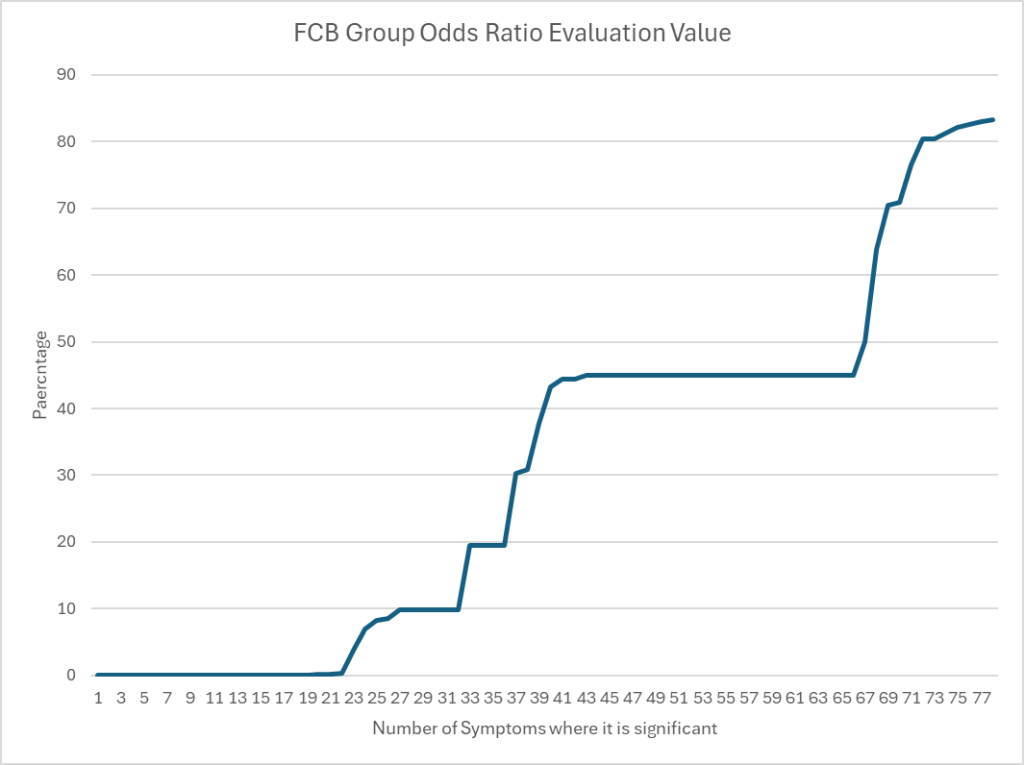
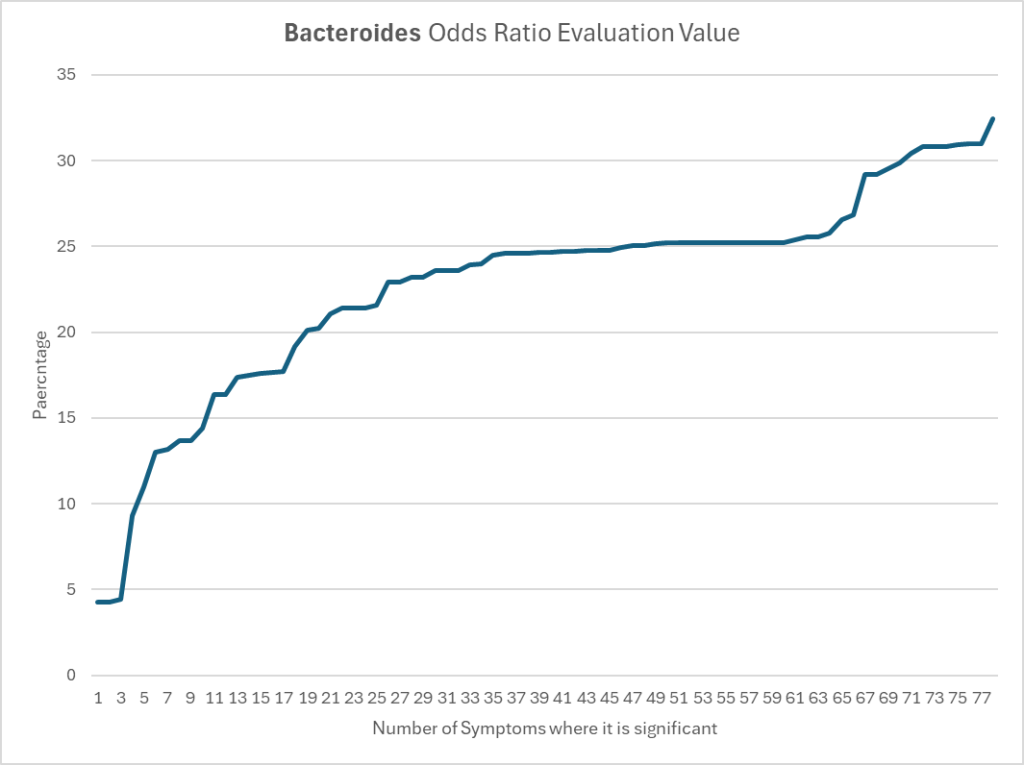
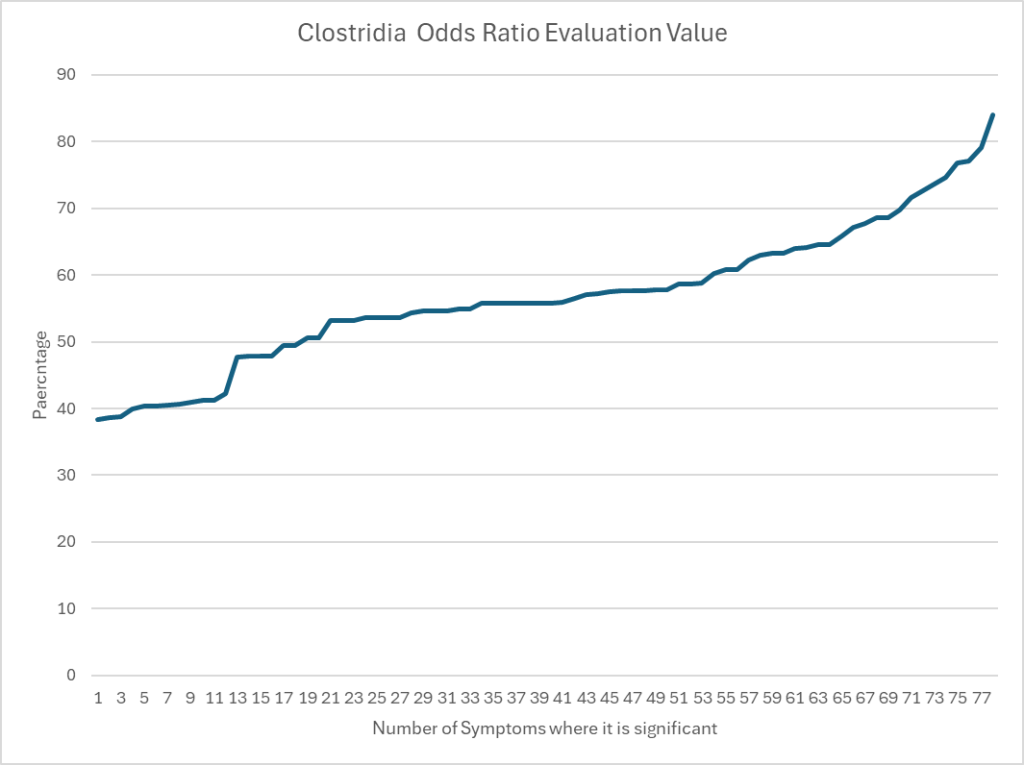





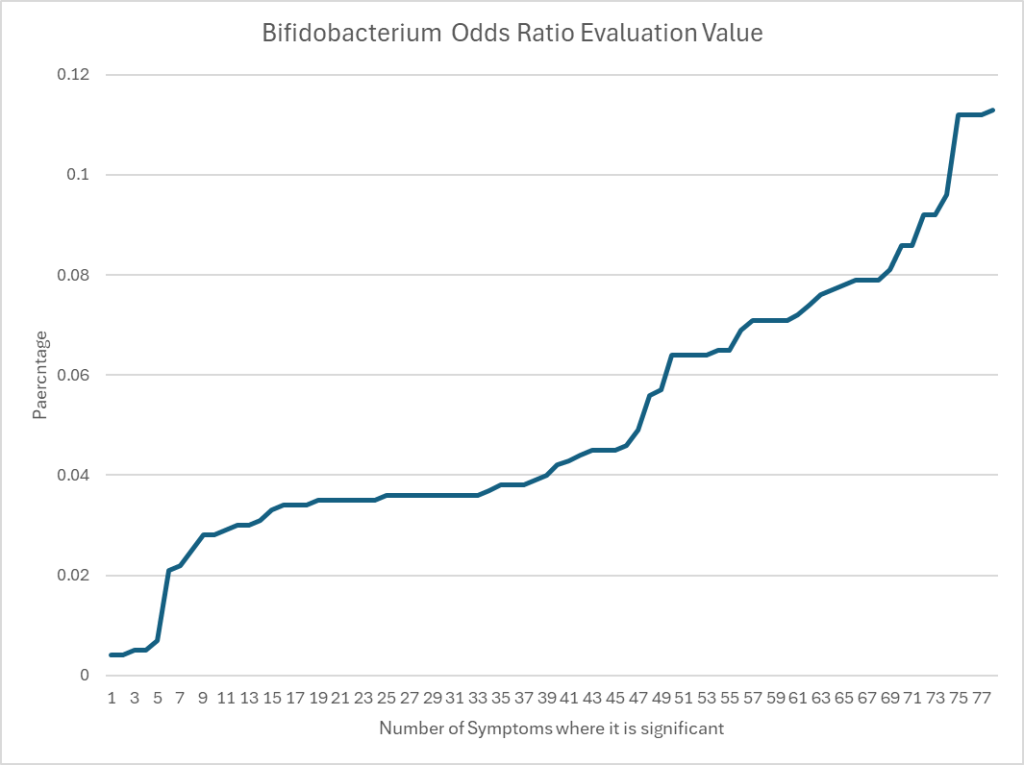
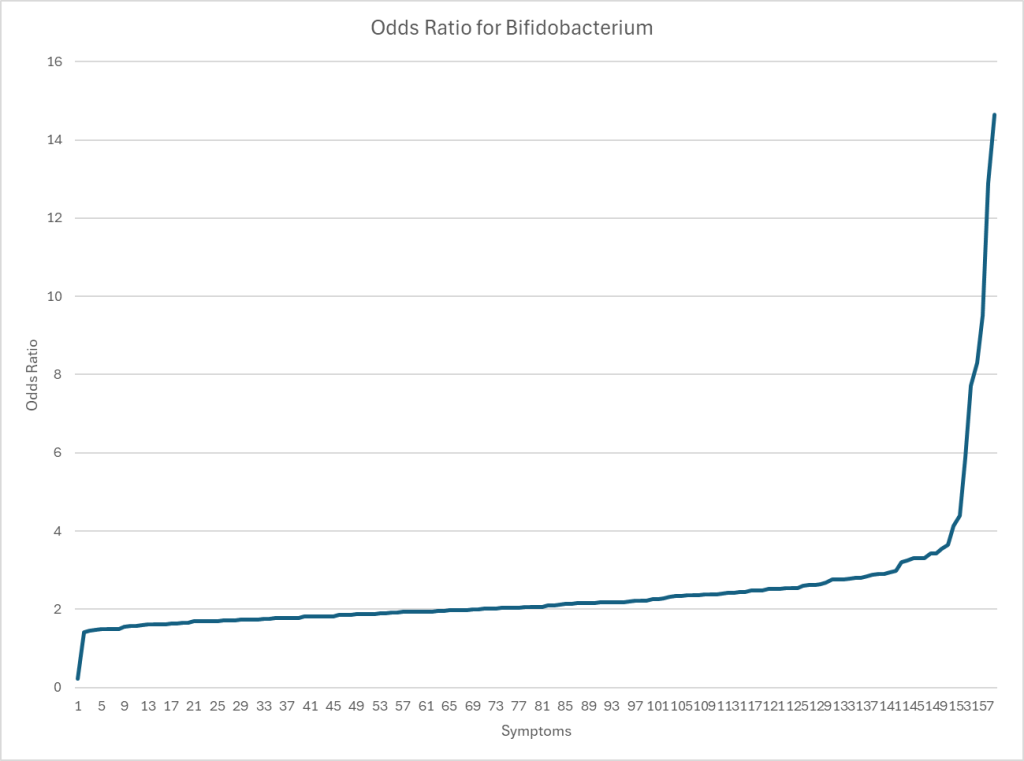
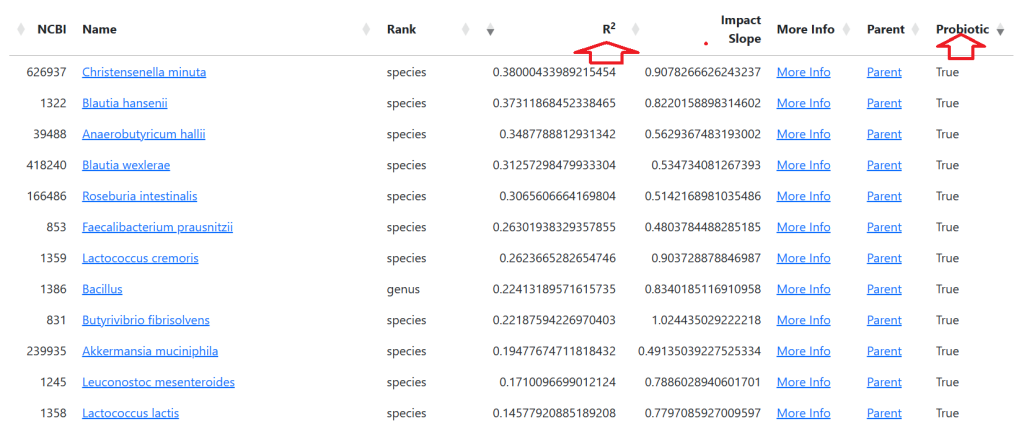





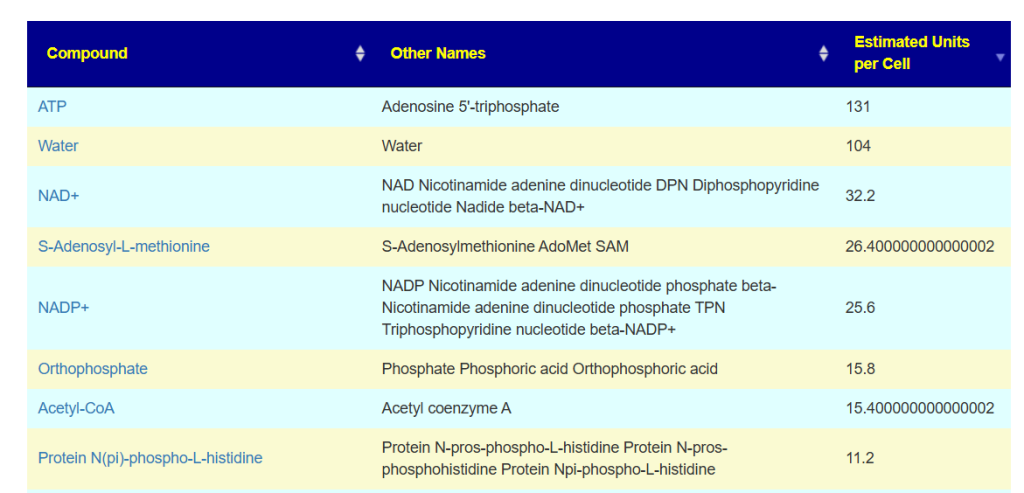

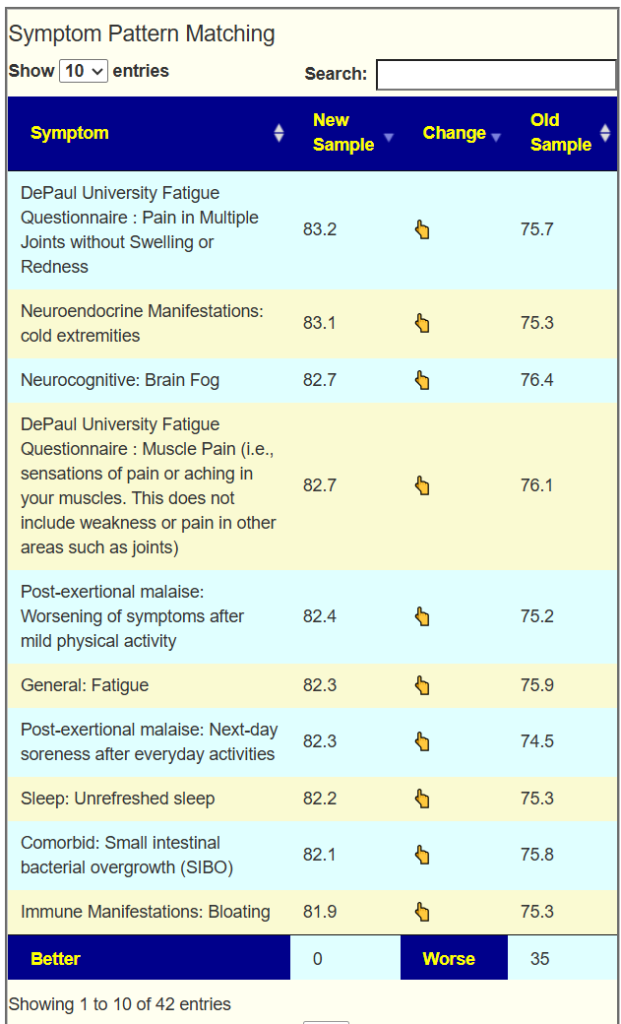
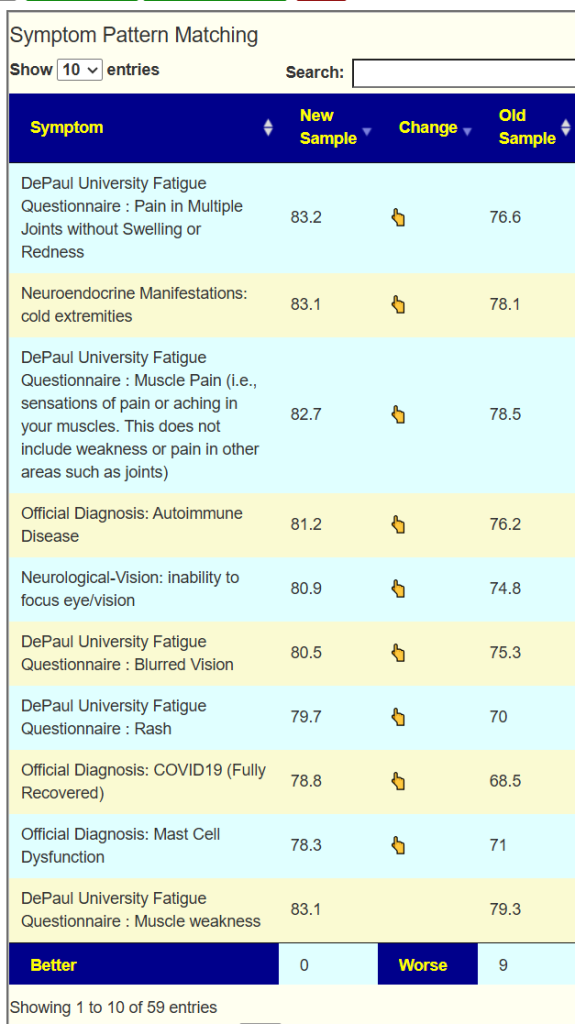






Recent Comments